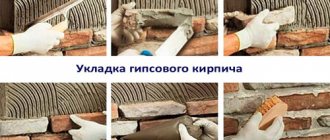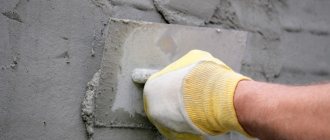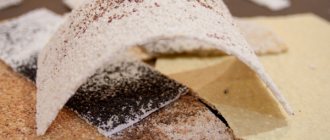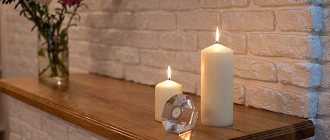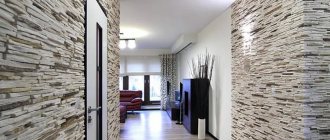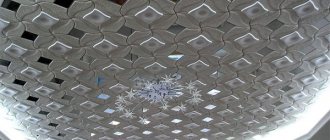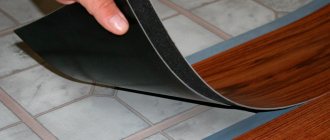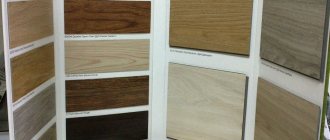Liquid Nails
Polymer composition with high adhesive characteristics. There are two types of such adhesives. The first is made on the basis of polyurethane and acrylic copolymers. This is a non-toxic, odorless mastic with low moisture and frost resistance. Suitable for gluing porous elements. Adhesive on neoprene has greater adhesion. But at the same time it is toxic, with a pungent odor. Reliably glues plates to any substrate.
- Construction Materials
What can be glued with liquid nails: 8 materials
Ready-made gypsum-based mastic
A composition specially developed for laying gypsum cladding. The most expensive of the possible options, it is also the most convenient. The mastic sets quickly, and the plate does not need to be held in place for a long time. Completely hardens in 24 hours. Excess paste can be used to rub joints. It is applied with a special spatula, which is placed in the package with the solution.
- Decoration Materials
How to lay decorative bricks: detailed instructions for flexible and hard materials
Advantages and disadvantages of gypsum brick
Gypsum bricks are quite a convenient, common, universal construction tool, which is used to lay out entire walls or certain areas of the room.
Gypsum brick can be combined with wallpaper and plaster to make the design more interesting.
The main advantages include:
- Environmental friendliness. They are made from environmentally friendly material that does not emit harmful substances that are harmful to human health, since they are made from natural materials;
- Low cost. Gypsum brick is considered the most affordable material for creating a brick wall. It is popular due to its low cost;
- A large assortment. On sale you can find bricks of different shapes, colors and textures. Thus, the design of the room will not be of the same type; everyone will be able to find and select a brick suitable for the overall design of the room;
- Prostate application. You can install gypsum bricks yourself; they adhere well to various surfaces. To do this, you do not need to have any specific experience or contact specialists;
- Light weight. Gypsum bricks do not put pressure on the surface and do not lead to its distortion, since they weigh little.
There are not many disadvantages, their main disadvantage is that they are very fragile. They may break if transported and used carelessly.
They are also afraid of dampness and high humidity. An element of a brick wall damaged during operation can be replaced without completely damaging the entire wall.
Video description
This video shows the installation of decorative gypsum stone:
Step 3. Laying tiles
It is important to properly prepare the adhesive composition first. It should be mixed until a thick mass is formed. The glue is applied loosely to the place where the tiles will be laid. The material itself is pressed tightly against the wall and held for a few seconds. It is better to remove residues and excess glue immediately using a special sponge.
Laying gypsum tiles under brick begins from the bottom corner, gradually moving to the central part. It is better to immediately lay out the stones in even rows without gaps or gaps, so as not to cover them with grout later. After installation, you can paint the joints with paint to match the color of the material to restore the original appearance, matching the base material.
Step 4. Checking the general condition
After the installation of all the tiles has been completely completed, it is worth assessing the general condition of the gypsum material. It is important to monitor each joint so that the distance between the tiles is not too large. If necessary, go through the grout again. If everything was done correctly, the gypsum stone will last a long time.
Laying gypsum tiles Source krrot.net
The use of gypsum bricks in the interior
More and more preferences in interior design are given to environmentally friendly materials or natural materials of natural origin. Natural materials are quite expensive, and repairs can require large material costs.
In such cases, you have to look for alternatives. Gypsum brick has become an excellent replacement for natural brick. It does not emit harmful substances that affect human health.
There are many bricks of various sizes and textures available for sale, thanks to which they can be used to decorate not only entire walls, but also be used to decorate windows, doorways and staircases.
Thus, gypsum brick can be used in classical design and in modern style.
You can pay attention to the following types of design using gypsum bricks:
- Romance. The use of brick in the design will not definitely make it much rougher, thereby creating the feeling of being on the street. Any material can be transformed in different ways; to do this, you need to choose the right color, texture and size of the brick; layout also plays an important role. It is necessary to select a color that matches the flooring and furniture. To create a romantic design, a brick wall is combined with openwork curtains, complementing the interior with delicate textures, colors and lighting to display the advantages of the wall.
- Pop Art. This design is suitable for fairly determined people who are not afraid of change. The interior is dominated by contrasting colors. This could be a combination of a white frame with bright furniture. You can also pair a red-orange structural wall with bright furniture in blue or green.
- Gothic. The design is not done in a gloomy style, but is skillfully complemented with elements of antiquity. It is enough to display it in a combination of black, white and beige, complementing it with wooden elements. In this style, furniture with a glossy surface goes well with the overall interior.
- Scandinavian style. A rather strict style, the main accent of which is the brick wall in natural shades. The most advantageous is the use of natural brick in gray and black colors in this style. It is important to select the color of the brick that matches the colors of individual parts of the interior, furniture and textiles. The strict Scandinavian style can be diluted with decorative elements, paintings, various vases and sophisticated chandeliers.
- Ethnics. A strict style that goes perfectly with bright shades. A gypsum brick wall is combined with ceramics; it is also possible to lay out a gypsum wall with hieroglyphs displayed. It is customary to decorate a brick wall in this style with various carpets and souvenirs, usually in the African style.
Recommendations when working with gypsum tiles
The final result is influenced by knowledge of all the intricacies of the process. Experienced specialists recommend taking into account the following nuances when working with gypsum bricks:
- The increased fragility of gypsum requires caution during installation;
- When laying decorative bricks in the kitchen, tile consumption can be reduced if the joint width is at least 8-10 mm;
- You can use scraps of the product, but in areas covered by furniture;
- The seams can be sealed with glue that protrudes during the process of pressing the brick into the surface of the base, which is done with rotational movements;
- The last stage is polishing the seams. The joints will also need correction, because after drying they change color. Therefore, the joints are painted over with water-based paint and varnished.
The increased fragility of gypsum requires caution during installation.
Engagement
Gypsum brick is considered a convenient material for finishing surfaces, but is significantly inferior in strength to ordinary bricks. In order for a brick wall to serve you for a long time, it is necessary to maintain the necessary conditions; in rooms with high humidity, it is not recommended to decorate the wall with gypsum bricks.
- A common design solution was laying gypsum bricks on the walls in the hallway.
- The decor of gypsum bricks on windows, doorways, and staircases looks original and unusual.
- You can use gypsum bricks in private and country houses.
If you live in a cottage, the stairs can be decorated with brick.
Installation features
The quality of laying the future gypsum surface depends on each stage. Therefore, it is worth approaching installation work with all responsibility. Laying gypsum tiles requires careful preparation and well-formulated materials. Only in this case will the material be used for a long time. Let's look at each step separately.
Laying tiles with your own hands Source sense-life.com
Gypsum brick at home
Construction stores offer many options for gypsum bricks, in various colors, shapes and textures.
If you wish, you can make gypsum bricks yourself at home, but for this you must have powdered gypsum, paraffin, silicone sealant, molding plasticine and a cardboard box.
In order to make gypsum bricks, you need to have a mold for casting bricks; you can purchase it ready-made, or make it from molding bricks or paraffin by pouring it into a cardboard box.
To make gypsum bricks at home, it is better to purchase gypsum grade GF10, as it is more durable and resistant to mechanical stress.
The process of making gypsum bricks is not complicated.
- At the first stage, it is necessary to make a gypsum mixture to fill the molds.
- Powdered gypsum must be combined with water according to the instructions provided by the manufacturer.
- Next, the molds are lubricated with oil or fat, which is necessary for easy removal of the finished brick.
- The mixture is poured into the mold and shaken a little to better compact the mixture.
- We wait for the drying time specified by the manufacturer. The brick is ready.
Briefly about the main thing
Gypsum for decorative stone is used in almost every modern design. This material is a budget and modernized version of conventional brick. It is lighter, easier to install and suitable for all types of surfaces. That is why when choosing an artificial surface, attention is paid to gypsum stone.
A large assortment allows you to choose the material for each room. But the types are very different from each other, so it is worth studying in detail the properties of each and comparing them with the technical characteristics of the room. You can do the installation yourself, but it is important to follow all the rules and strictly follow the instructions. Only then will gypsum tiles become an excellent addition to the interior of the house.
Ratings 0
Photo of gypsum brick in the interior
The most common mistakes made when installing yourself
When installing decorative stone yourself, you can make a mistake. The most common mistakes made by experts:
- A lot of waste due to improper cutting of tiles;
- An incorrect primer or a violation of the technology for applying the primer;
- Excessively wide or sloppy seams;
- Violation of row levels.
Gypsum brick is a modern and very easy-to-work material that allows you to install it yourself.
Gypsum brick is a modern and very easy-to-work material that allows you to install it yourself. If all requirements are met, you can count on excellent results and long-term operation.
Tips for caring for tiles
Gypsum coating can be maintained using dry and wet cleaning. It is permissible to use a vacuum cleaner with a special attachment, soft-bristled brushes, and damp rags. Abrasive materials and aggressive detergents can cause irreparable damage to the surface. The varnish coating significantly reduces the risk of damage to the top layer. To ensure the finish is resistant to moisture, it is treated with a special impregnation. After applying this product, the cladding can be washed.
